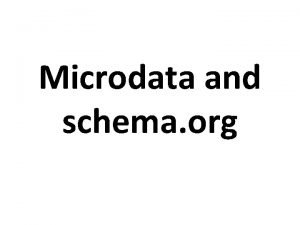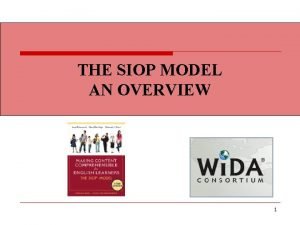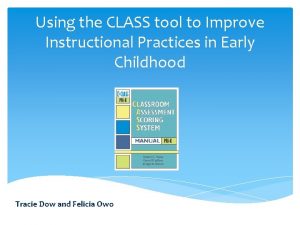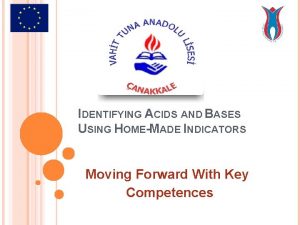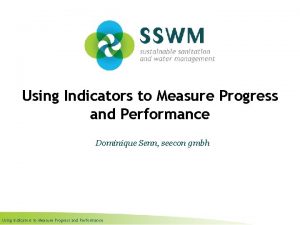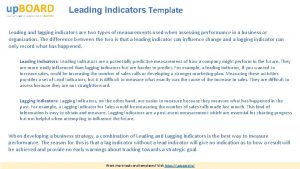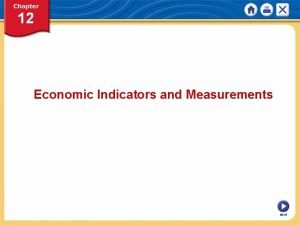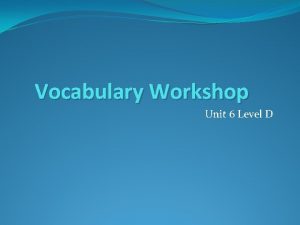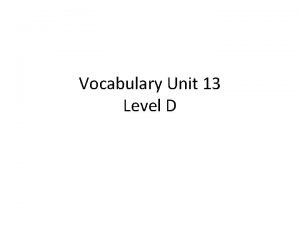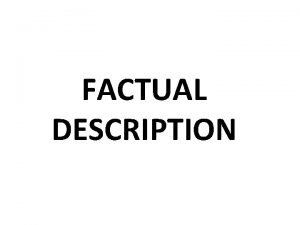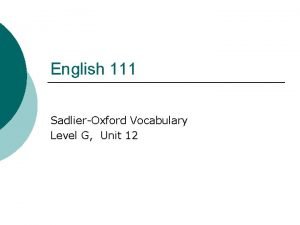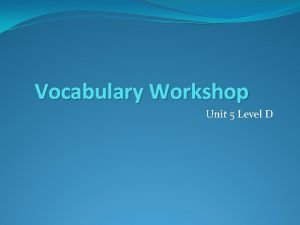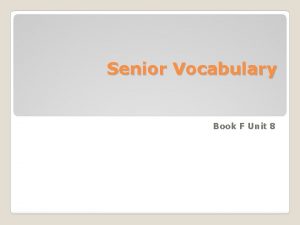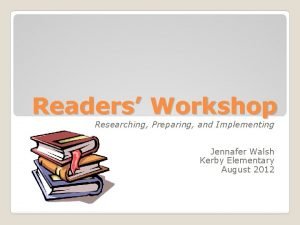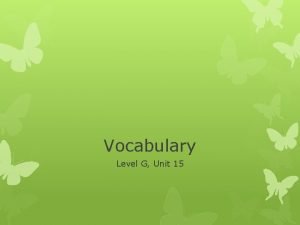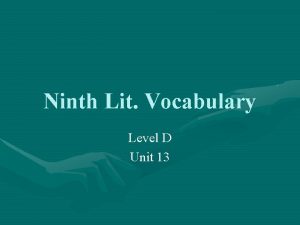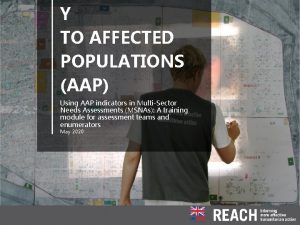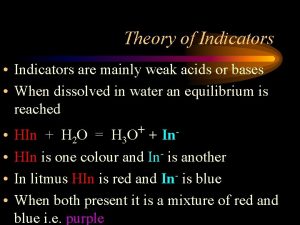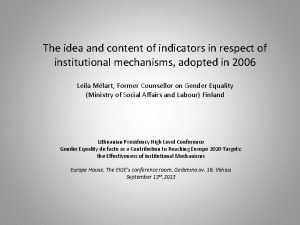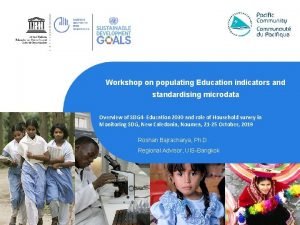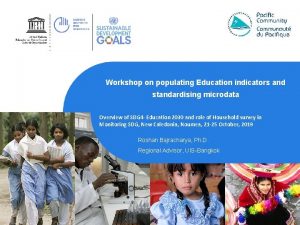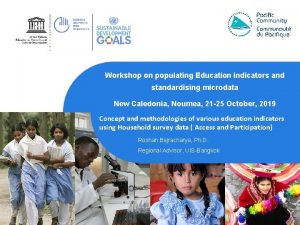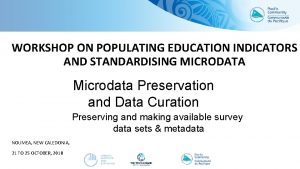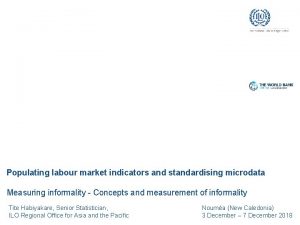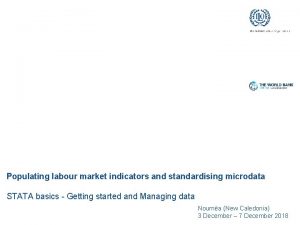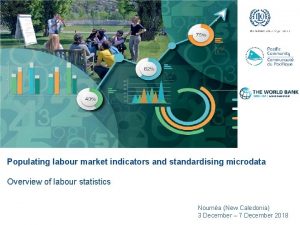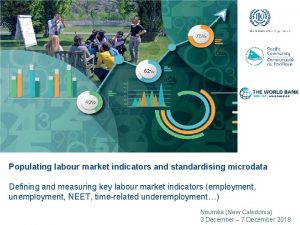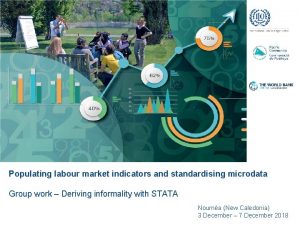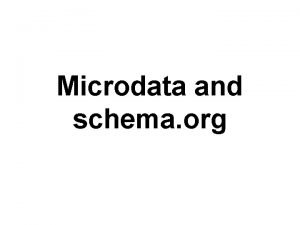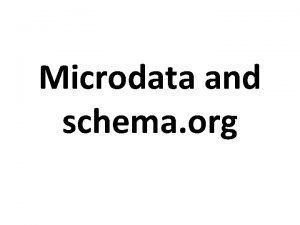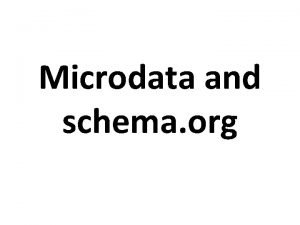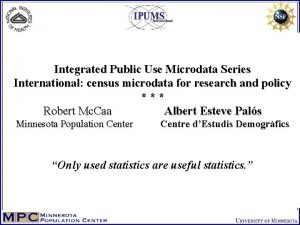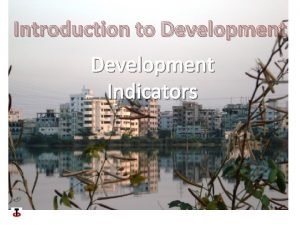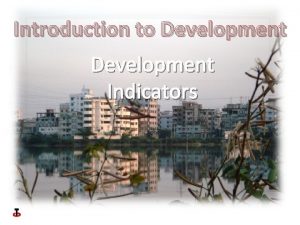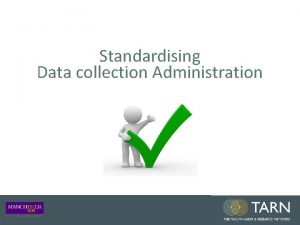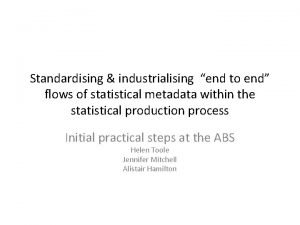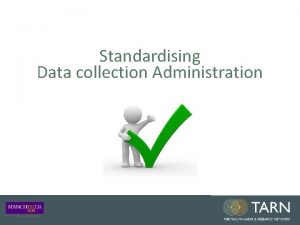Workshop on populating Education indicators and standardising microdata




























- Slides: 28

Workshop on populating Education indicators and standardising microdata New Caledonia, Noumea, 21 -25 October, 2019 Introduction into International Standard Classification of Education (ISCED 2011) Roshan Bajracharya, Ph. D. Regional Advisor, UIS-Bangkok

Contents • Education Monitoring Indicators Frameworks • Education Indicators - Concepts and Methodologies • SDG 4 Monitoring and Household Surveys

ISCED International Standard Classification of Education What are international statistical standards? • They should provide a common frameworks for collecting and organising information about a particular statistical system • They should facilitate exchange and comparability of statistical information between countries and agencies • They are applied to the structure and content of data and metadata, and perhaps to the statistical production process Comparability is the KEY for International Education Statistics

Can you compare education indicators from these countries? Different Countries, different Education Systems Design of programmes at primary education: Comparable Indicators prepared nationally are not comparable at the regional or global levels

Because …. . • Their educational systems and their methodologies to calculate indicators are different. • In some countries, even at the national level, two different data providers will have different sets of indicators. 5

Ensuring Comparability at the International level In addition to ISCED, o Ensuring that the entire country, all educational institutions and groups are included in the data; o Population used is from UN Population Division (UNPD) o Economic data (e. g. GDP, exchange rates) are provided by the World Bank or the International Monetary Fund (IMF)

ISCED quick chronology 1958, UNESCO recommendation on classifying educational programmes 1976, ISCED classification was introduced 1997, ISCED 1 st revision 2011, ISCED review and 2 nd revision

What is an ISCED? ISCED is… • A FRAMEWORK to facilitate comparisons of education indicators across countries • A METHODOLOGY for translating national educational programmes into an internationally comparable set of categories Is a product of international agreement adopted by the General Conference of UNESCO Member States and maintained by UIS • ISCED is not… • A means of measuring the quality of an education programme • The definition of the coverage of the UIS or other education surveys • An ideal model for reporting national statistics on education

The Key Elements of ISCED 2011 • Units of classification (Programmes) • Scope of education in ISCED (Coverage) • ISCED levels (clear explanation on each of the level) • Cross‐classification variables (orientation, completion, etc. )‐ to differentiate different programms within the same level

Three Components of ISCED • Internationally agreed concepts and definitions (See paras 10 to 88 and the Glossary in Annex 5) • The classification system and definition of each level of education (with all classification criteria) (See Sections 7 and 9‐ 19 and Annexes 2‐ 3) • The ISCED mappings of educational programmes and related qualifications (Available countries’ mappings of 1997 and 2011 are on UIS website)

Some definitions • In ISCED terms, EDUCATION is: “an organized and sustained communication designed to bring about learning” • Organized: “planned…with explicit… aims” (it is deliberate and intentional) • Sustained: “duration and continuity” (very short or “one-off” learning experiences are not covered) • Communication: “a relationship between TWO or MORE PEOPLE involving the transfer of information” • Learning: “any improvement in behavior, information, knowledge, understanding, attitude, value or skills”

ISCED coverage and limits: Not only regular education but not all learning Institutionalized, intentional and planned with continuous pathways Institutionalized, intentional and planned without continuous pathways and no formal recognition

What does ISCED classify? Educational programmes (not the institution, the students, the courses or the qualifications) are “[…. ] designed and organized to achieve pre-determined learning objectives or accomplish a specific set of educational tasks over a sustained period. ” Two units of classification: 1. The Educational Programme is ‘a coherent set or sequence of educational activities that are designed and organized to achieve pre‐determined learning objectives or accomplish a specific set of educational tasks over a sustained period. ’ 2. Related Recognized Qualifications is ‘The official confirmation, usually in the form of a document, certifying the successful completion of an educational programme or of a stage of a programme. ’ • ‘They may be obtained through: successful completion of a full programme or a stage of a programme (intermediate qualifications) or by the validation of knowledge, skills and competencies, independent of participation in such programmes. ’ • Credits are not qualifications

How is ISCED constructed? • ISCED attempts to classify the curriculum content of education programmes • Usually by using proxy criteria s nswer a / s n io quest e s o h T lassify o ISCED c o t help es int m m a r prog • • What is the starting age? (Age of admission) What is the typical duration? Minimum duration? What are the qualifications awarded? What qualifications do teachers have? What are the entrance requirements? What does the programme lead to (destination)? What is the orientation?

The application of ISCED In theory… • Make a thorough list of all national programmes and their characteristics • Use the proxies of programme content to establish the levels • Examine the main and subsidiary criteria at each level (to define the bounderies between the levels) • Determine the orientation and destination

Second component of ISCED 2011 The classification system and definition of each level of education (with all classification criteria) (See Sections 7 and 9‐ 19 and Annexes 2‐ 3)

ISCED levels ISCED 2011 ISCED 1997 0 Early childhood education 01 Early childhood educational development (designed for children aged under 3 years) 02 Pre-primary 0 Pre-primary (designed for children aged 3 years and above) 1 Primary (or 1 st stage of basic education) 2 Lower secondary (or 2 nd stage of basic education) 3 Upper secondary 4 Post-secondary non-tertiary 5 Short cycle tertiary 6 Bachelor’s or equivalent level 7 Master’s or equivalent level 5 First stage of tertiary 8 Doctoral or equivalent level 6 Second stage of tertiary

Transition Pattern Building on Sec ed. Designed for individuals who completed ISCED 3 for progression to tertiary or to the job market where ISCED 3 does not grant Min 2 yrs, practical based‐labor market Below Bach‐ can lead to higher tertiary levels Educational content designed for children aged 0 ‐ 2 years Two types of ISCED 0 ECE Educational content designed for children aged at least 3 years Bachelor, First tertiary degree, no direct access to ISCED 8

Cross-classification variables ISCED 2011 Orientation (ISCED 2 -8) v General/academic v Vocational/professional Completion/access to higher ISCED levels v Level completion and access to higher ISCED level (whether on direct path to ISCED 8 or not) Level completion (but no direct access to higher ISCED levels) v Partial level completion (no direct access to higher ISCED levels) v No level completion (nor direct access to higher ISCED levels) v

Completion and access to higher levels of education (ISCED 2 and 3) Partial level completion is used where there is a sequence of two or more programmes within ISCED level 2 or 3. Completion of an educational programme Doen’t meet ISCED level criteria Meets ISCED level criteria Not sufficient to complete ISCED level Sufficient to complete ISCED level Doesn’t give access to higher ISCED level Insufficient for level completion Partial level completion Level completion without access Give access to higher ISCED level Level completion with access Successful completion of a programme which is not the last in the sequence of: at least 2 years in the level and at least 8 years (ISCED 2) or 11 years (ISCED 3) cumulative duration since the beginning of ISCED 1

ISCED Coding 3‐digits scheme • Digit 1 – levels of education • Digit 2 – categories • Digit 3 – sub‐categories 2 Lower secondary 24 general 25 vocational 241 insufficient for level completion or partial completion, no access 242 sufficient for partial level completion, no access 243 sufficient for level completion, no access 244 sufficient for level completion with access 251 insufficient for level completion or partial completion, no access 252 sufficient for partial level completion, no access 253 sufficient for level completion, no access 254 sufficient for level completion with access

CODING OF EDUCATIONAL ATTAINMENT ATTAINME NT 0 less than primary Orientation COMPLETION Coding 01 Never attended an education programme 010 02 Some early childhood education 020 03 Some primary education (without level completion) 030 1 primary 10 Primary 100 Including recognized successful completion of a lower secondary programme insufficient for level completion or partial level completion 100 2 L. Secondary 24/25 General/Vocational 2 Partial level completion, without direct access to upper secondary education 3 Level completion, without direct access to upper secondary education 4 Level completion, with direct access to upper secondary education 1 242/252 243/253 244/254

ATTAINME NT Orientation COMPLETION 3 SECONDAR Y 34/35 General/Vocational 2 Partial level completion, without direct access to tertiary education 3 Level completion, without direct access to tertiary education 4 Level completion, with direct access to tertiary education 1 Coding 342/352 343/353 344/254 4 Post Sec Non Tertiary 44/45 General/Vocational 3 Level completion, without direct access to tertiary education 4 Level completion, with direct access to tertiary education 1 443/453 444/454 5 Short‐ cycle tertiary education 54 General 55 Vocational 56 Orientation unspecified 0 no details provided 540 550 560 6 Bachelor’s or equivalent 64 Academic 65 Professional 66 Orientation unspecified 0 no details provided 640 650 660

ATTAINME NT Orientation COMPLETION Coding 7 Master’s or equivalent level 1 74 Academic 75 Professional 76 Orientation unspecified 0 no details provided 740 750 760 8 Doctoral or equivalent level 1 74 Academic 75 Professional 76 Orientation unspecified 0 no details provided 840 850 860 9 Not elsewhere classified 999 6 Bachelor’s or equivalent 64 Academic 65 Professional 66 Orientation unspecified

Third component of ISCED 2011 The ISCED mappings of educational programmes and related qualifications

ISCED mapping – Why? 1. ISCED mappings are an essential tool for organising information about national education programmes and related qualifications in order to ensure the cross‐national COMPARABILITY of statistics and indicators on education. 2. ISCED mappings ensure a TRANSPARENT process of coding national educational programmes and related qualifications into comparable categories for use in international statistics by linking the classification criteria to the properties of the educational programmes and their related qualifications.

ISCED Mapping is…. . In simple words: …A visual presentation of the national education structure, with a breakdown by ISCED level

Data to transform lives Roshan Bajracharya, UIS‐Bangkok r. bajracharya@unesco. org Learn more http: //uis. unesco. org/ @UNESCOstat #Fund. Data
 Schema.org
Schema.org Public use microdata sample
Public use microdata sample Northwind data warehouse
Northwind data warehouse Siop and tap have similar descriptors and indicators
Siop and tap have similar descriptors and indicators Difference between als and formal education
Difference between als and formal education Similarities between health education and health promotion
Similarities between health education and health promotion Class domains and dimensions
Class domains and dimensions Homemade indicators for acids and bases
Homemade indicators for acids and bases Sports and entertainment marketing performance indicators
Sports and entertainment marketing performance indicators What are cream and spiced indicators
What are cream and spiced indicators Identify three effects of low humidity s190
Identify three effects of low humidity s190 Leading and lagging indicators powerpoint template
Leading and lagging indicators powerpoint template Chapter 12 economic indicators and measurements
Chapter 12 economic indicators and measurements Types of extension education
Types of extension education Unit 4 level d synonyms
Unit 4 level d synonyms Vocabulary workshop level d unit 13 synonyms and antonyms
Vocabulary workshop level d unit 13 synonyms and antonyms Factual description on event
Factual description on event Vocab unit 12 level g synonyms
Vocab unit 12 level g synonyms Unit 5 level f vocab
Unit 5 level f vocab Level f unit 8 synonyms
Level f unit 8 synonyms Monty's noodles montmorency
Monty's noodles montmorency Pros and cons of reading workshop
Pros and cons of reading workshop Workshop health and safety poster
Workshop health and safety poster Unit 15 level g vocab
Unit 15 level g vocab Synonyms and antonyms
Synonyms and antonyms Msnas
Msnas Indicators of potential workplace violence
Indicators of potential workplace violence Theory of indicators
Theory of indicators Respect indicators
Respect indicators
